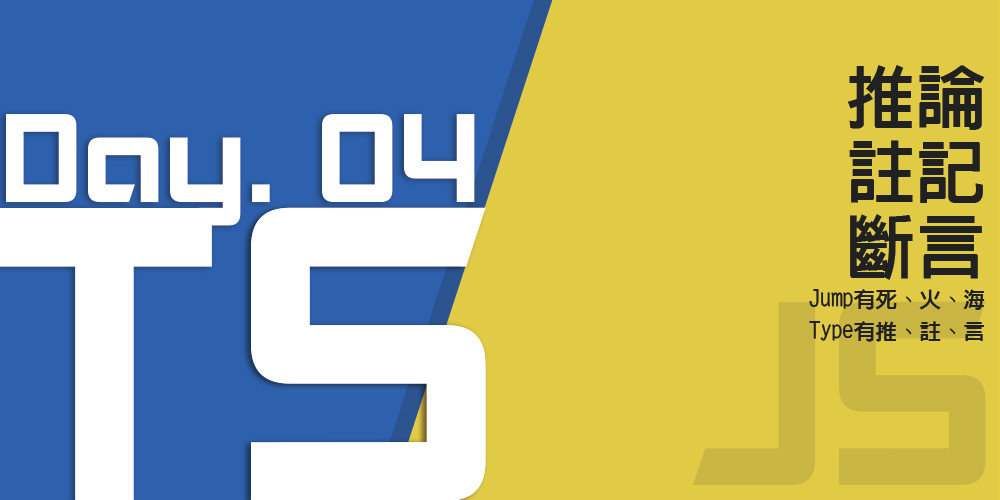[Day04] - 一切的源頭 - 推論、註記、斷言

所以說那個Type呢?
Jump有死、火、海
Type有推、註、言
───────────────────────── By Opshell
目標:初步了解TypeScript是如何Type的
TypeScript adds additional syntax to JavaScript
to support a tighter integration
with your editor. Catch errors early in your editor. ───────────────────── By TypeScript
翻譯來大概就是:TypeScript 透過增加一些東西來擴展 JavaScript。
增加了什麼? Types(型別)、ECMAScript標準的實作及擴展等。
整個TypeScript的重點幾乎都在於如何定義程式碼的Types(型別),
那我們開頭先來講講TypeScript定義Types(型別)的三種主要概念。
過程:
三種主要的模式
| Title | 型別推論 | 型別註記 | 型別斷言 |
|---|---|---|---|
| 英文 | Inference | Annotation | Assertion |
| 模式 | 被動 | 主動 | 主動 |
| 內容 | 自動推論資料型別 | 大多使用在初始化階段,例如宣告變數、函式參數等 | 手動指定、選擇一個值的型別 |
| 後續內容稱呼為 | Inference(推論) | Annotation(註記) | Assertion(斷言) |
※ 後面文章會總稱他們為Type法(Type化的方式)
看一下他們大概的使用方式 (你告訴TS你要什麼)
1.
Inference(推論)(TS猜你要什麼) JavaScriptlet year = 'Thirty'; year = 30;1
2這段程式在JavaScript完全不會有問題, 但是在TS就會叫了‧
 在你宣告時,他會根據的預設的值猜你變數的型別。
在你宣告時,他會根據的預設的值猜你變數的型別。2.
Annotation(註記)像註解一樣,只是註解的方式變成冒號
javascriptconst plusThirty = function (num) { return num + 30; };1typescriptconst typePlusThirty = function(num: number) {return num + 30;}1💡 錦囊 [Tips]:
型別宣告後,就不能使用其他型別進行賦值,
否則會報錯(當然還是可以編譯成Js檔),
有效預防錯誤、統一規格、提高可讀性,方便多人協作。3.
Assertion(斷言)(我說我要什麼) 雖然有時候變數可能有多種型別,
在需要的時候利用Assertion(斷言),
從多種型別中指定你要的型別。
※Assertion(斷言)有兩種寫法typescript// 第一種 <型別>值 let say: any = 'Hello'; let helloCode = <string>say;1
2
3typescript// 第二種 值 as 型別 let say: any = 'Hello'; let helloCode = say as string;1
2
3※ 兩種效果相同,若是開發
React專案使用JSX語法時只能用第二種下面的例子就是用
Assertion(斷言)選擇Type:JavaScript// 在JS中,這是很常見的使用方式 const ops = {} ops.age = 30; ops.gender = 'man';1
2
3
4typescript// 但是在TS中是會報錯的 const ops = {}; ops.age = 30; // Error: property 'year' does not exist on `{}` ops.gender = 'man'; // Error: property 'gender' does not exist on `{}`1
2
3
4ops 的
Inference(推論)是沒有任何屬性的物件,
因此,不能在屬性上添加 age 或 gender,
這時候透過Assertion(斷言)可以避免這個問題ts// 先建立一個 Interface(介面) // Interface(介面) 是個原先JavaScript沒有的概念, // 對我來說 他有點像個模型,現在先有個印象就可以了, // 後面會詳細介紹。 interface IMember { age: number; gender: string; } const ops = {} as Member; // 或者是 const ops = <Member>{} // 這時候就可以指定資料了 ops.year = 30; ops.gender = 'man';1
2
3
4
5
6
7
8
9
10
11
12
13
14
15
16這時候也許就會想了,那
Interface(介面)能不能當作Annotation(註記)的型別呢? 測試了一下發現他是會報錯的tsinterface IMember { age: number; gender: string; } const ops: IMember = {};1
2
3
4
5 使用
使用Annotation(註記)的方式宣告,需要完整的宣告完他的參數。 可以是一種叫做excess property checking(額外檢查)的機制, 他會比對每個 Key,解法後面會再提到喔~tsinterface Human { year: number; gender: string; } const ops: Human = { year: 30, gender: 'man' };1
2
3
4
5
6
7
8
小結:
今天的小例子,應該對TypeScript的型別化方式有一定的了解, 大概有三種主要的方式與特性來宣告型別。 Inference(推論)、Annotation(註記)、Assertion(斷言) 我覺得,這三種沒有誰比較好,在合理運用的情況下,他們可以相輔相成, 有良好的coding體驗的情況下又不會增加太多負擔。 在後面的筆記中,會越來越熟悉如何互相配合。

